Page 10: October 1976 to June 1978: Photo school in England
(City and Guild Diploma, photo 745 from Berkshire College of Art and Design) Course 745 was technical photography, 744 in artistic photography.
I choose 745, because, as Edward Weston once said:
“… to
consult the rules of composition before making a picture is a
little like consulting the law of gravitation before going for
a walk. Such rules and laws are deduced from the accomplished
fact; they are the products of reflection.”
The Parisian schools (all two of them, at the time) declared
that they did not teach flash photography, a too-recent
technique definitely transgressing all the best traditions and
cultures! Of course flash-photography was already used
everywhere in England.
I met Tim Horrox, now owner/manager of a large audio-visual production
company in Aylesbury, England (http://www.hmx.cc).
I met Mark Holliday, now also a great photographer in England (markholliday.co.uk).
.
Because my professors all agreed that I was marvellously gifted
in photography, perhaps with perfect visual perception, maybe
even the Mozart of photography, they authorised me to skip out
on certain classes in electricity and chemistry, because, given
my Masters, I knew more than them! This allowed me to have
other jobs at the same time and earn my
living.

En France à cette époque approx 1978 (est-ce que cela a changé ?), on passait ses exams, sans vraiment savoir ce qu'ils voulaient dire. J'ai fait bac C. "Bon, vous êtes bon en Math, faites MathSup, bon, puis MathSpé, puis 4 années de fac science. Super. "Quels sont les débouchés ?" Il n'y en a pas. ????? Sauf enseigner. Donc j'enseignerai quelque chose dont les débouchés sont "l'enseigner" ?????? Vive la France !
En Angleterre, les écoles sont très intéressées à la vie active. À la fin de mon école de photo de deux ans, j'ai récupéré nom diplôme et dans le couloir, un panneau d'affichage dit: "cherche assistant photographe pour Los Angeles". 3 jours plus tard, je débarque à LA. Je balaye le studio photo, je fais les cafés, etc... J'écoute les conversations clients-photographes.
Berkshire College of Art and
Design version 2013. I returned during my
“pilgrimage”.
On my first day of class at the
Photography College, the professor asked us “Who invented
photography?”.
Ever the enthusiastic student, I answered "Nicéphore
Niépse", because this is a well-known fact in France.
The entire class looked at me as though I came from another
planet.
In England, everyone knows that it’s Fox Talbot who invented
photography. The English Channel is a large gap. Well, they did
both invent methods, more or less the same, at the same time,
more or less.
I wanted a photographic memory, but I never developed it.



J'ai revu Tim Horrox le 15 mars 2025 !
Christian, it was great to see you again after all this time. Glad you could join us and thank you for the tour. I think I managed to come away without a single photo with you in, so do send any you have on your phone! And we’ll make sure it’s warmer next time! Stay well. Tim & Rachel.
I learned a whole bunch of things. For example: At the time, films weren’t very sensitive, 400 ASA max (we say ISO nowadays). You couldn’t use a fast shutter speed in low-light environments. I learned how to take a shot at the right moment to get a clear photo of a moving object: the moment where this object begins to fall. When a dancer jumps into the air for example, she stops moving at the instant where she reaches her summit and begins to fall back down, gravity oblige. Number 1 free photography tip by Christian Fournier.


Sinar 4x5” P2 View camera, with its tilt and shift capabilities and the Scheimpflug principle which allowed one to obtain the maximum depth of field.
The viewfinder image was upside-down.
4x5" Sinar P2 film camera. The large format has 2 main advantages:
• The greater size of the film and sensor means that you can make bigger blow-ups, or have a more finely detailed image, compared to small or medium format cameras.
• The modular construction of the camera makes tilting and shifting possible, which was rarely the case on lenses for smaller cameras. This gives you a lot more power over the perspective and focus.
The front and back bodies are equipped with commands allowing tilt and shift movements.
The observed image is inverted because, unlike in smaller cameras, there is no prism correcting it. This isn’t a problem for a professional photographer, after a bit of time to get used to it.
You focus by moving the back body along the optical bench. You can correct any apparent perspective errors using shift movements. As you might know, the perspective of an image is determined by the relative positions of the object plane and the image plane.
To put it plainly, if you want to photograph a vertical object, this means that your image plane (in this case, the plane of the film in the camera) has to be vertical too, so that the object’s parallel vertical lines will be parallel in the photo. This is how you avoid image distortions like the “pyramid effect” you find on photos made with small cameras directed upwards to photograph buildings.
As for the tilt movement, this lets you correct the blurriness of a photo. In this case, image sharpness depends on the relative positions of three planes, that of the subject, the lens, and the film. This is “the Scheimpflug principle”. As long as the three planes are parallel, the sharpness of the whole image is assured, but if one of the planes is tilted compared to another, then the whole image will only be sharp if the three planes extended meet up along the same line, that is they have a common intersection.
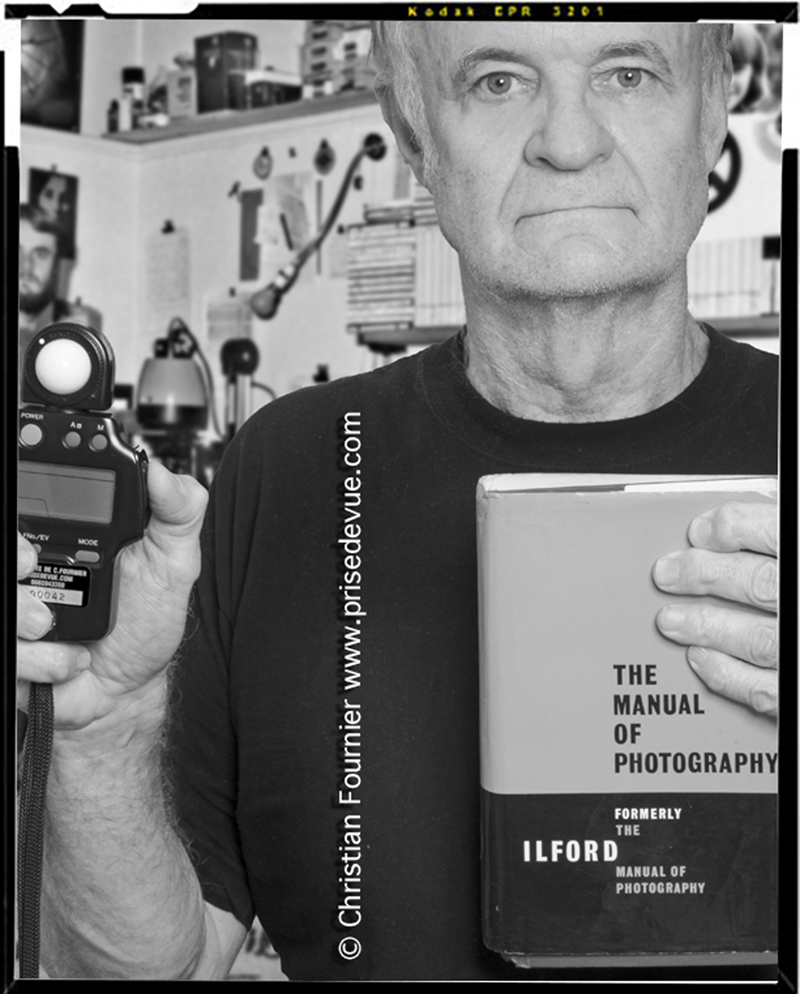
The sheet film, here in positive, used
in a 4x5” view camera.
Note the notches in the upper right, they allow you to identify
the emulsion side when placing it in the
film-holder.

NON, je n'ai pas connu l'époque des négatifs en verre, il faut pas exagérer non plus !
Le Rolleiflex mono objectif, format 120 (les négatifs font
6x6 cm), très bonne qualité, mais problème de parallaxe dû aux
2 objectifs et mise au point difficile en basse lumière.
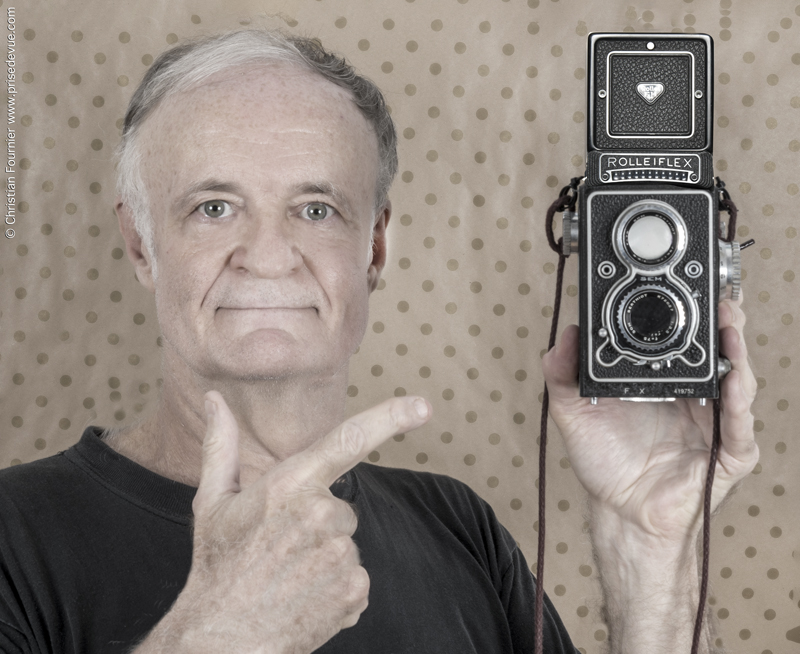




My old apartment, the 2013 version. The houses all have identical architecture!
Version 1977

My appartment/studio, all in one room: photo studio, processing, audio-visual, sharing shower and toilets one floor below. Already the sens of set up.
Little did I know in 1978 that I would be displaying this on a World Wide Web in 2016. I envisioned more of a beautiful book, next to those of Avedon, Cartier Bresson, etc.…
I saw myself driving in a Bentley towards my castle/photo studio of 920 square meters. A man can dream, can't he?
Anyway, I think I took some great photgraphs in my career.

|
1 - Future grand photographer Christian Fournier. Self taken photo, with my Nikon F, delayed action, tripod (not pedestal!).
2 - Projection screen, folded in its protected metal cylinder, for my slide shows and also as a white background for portraits.
3 - Enlarger Hael (or Crocus Color 69s ?)
4 - RolleiFlex 6x6cm (2 and a quarter squared) two-lenses (one for viewing and focusing, one for taking the photo), waist level finder.
5 - Record player, probably a "Linn". I changed frequently, thanks to my job as a Hi-Fi salesman, to pay for my photo school at Berkshire College of Art and Design in Reading, UK.
6 - Zero Halliburton case, waterproof, to protect my precious negs and slides. Duplicates were not good in 1978. This case proved useful, since I still have my original work intact in 2016.
7 - Spool used in my reel to reel tape deck, Teac or Akaï, see #16.
8 - Pre-amp QUAD 303 of my Hi-Fi. The power amp Quad 33 was hidden. There was no controls on it.
9 - Electric heater. I had to put coins in the British Electric meter.
10 - Black plastic sheet to transform my apartment into a darkroom or projection room.
11 - My very first soft toy, "Ilford", because black and white, a friendly device for focusing, which was not easy on a 4x5" or 8x10" camera. I lost it aeons ago, but found a new similar one in 2015.
12 - Magnetic tapes for my reel to reel, Teac, Revox or AkaÏ. Beatles, Pink Floyd, Mozart, Beethoven....
13 - Patterson System 4 developing tank system.
14 - My own prints, black and white or Cibachrome, made in this very room. My Cibrachromes are still with me, they have not changed in 38 years !
15 - Red light bulb for black and white printing.
16 - Reel to reel tape deck, Teac or Akaï. I changed frequently, thanks to my job as a Hi-Fi salesman.
17 - Chest of drawers for the photo accessories and eventually some socks.
18 - Films, papers and photo chemicals.

2019 : Personne ne peut dire que tu n'as pas consacré toute ta vie à ton métier. Vraiment remarquable et une œuvre qui reflète ton dévouement.
|
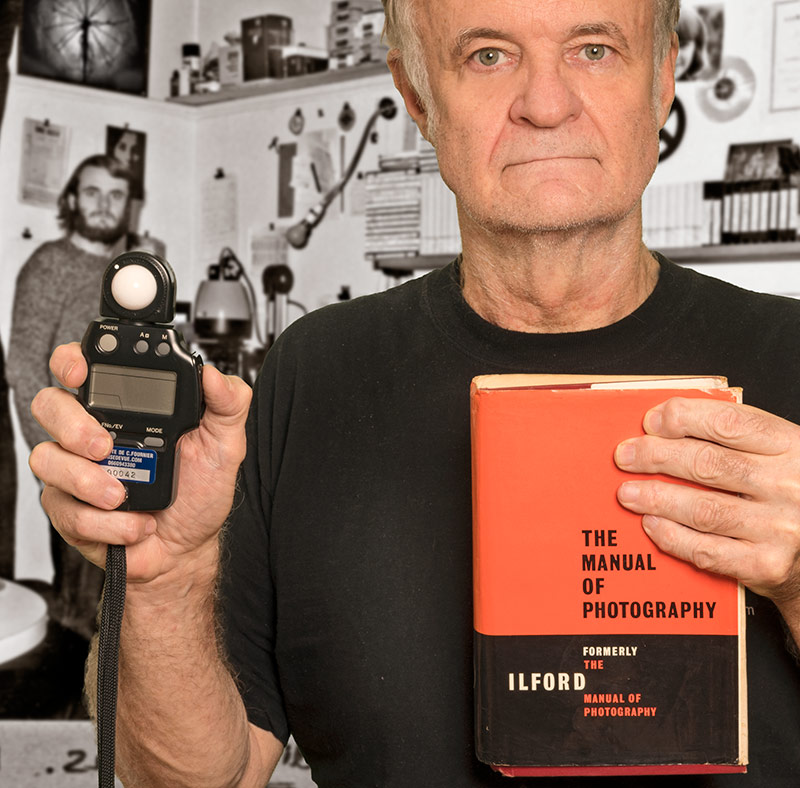
The Ilford Manual of Photography is a comprehensive manual of photography, first published in 1890,
written by C.H. Bothamley, and published by the Britannia Works Company, which became Ilford, Limited, in 1901.
It is still in print, in 2020, now named The Manual of Photography.
Technical information regarding optics, chemistry and printing are described in far greater depth than in other photographic books,
and therefore it quickly became the staple technical book for the professional or serious amateur photographer.
It remained so for some time, and with each additional edition further information was added so that it might remain relevant.
It still lines the bookshelves of many serious photographers, consequent to its tremendous depth,
and the publication of many of the recipes for developers, including the popular ID-11 and IF-2, Ilford Photo's then non-hardening fixer.
This represents a tremendous boon for the photographer, and did even more so in the early 20th century, when many would mix their own chemistry.
It is comparable in many ways to Ansel Adams' books The Camera, The Negative and The Print,
in its logical description of exposing film (and plates), developing the negative, and printing from those negatives.
This book was our reference while I studied photography from October 1976 to June 1978 in England
(City and Guild Diploma, photo 745 from Berkshire College of Art and Design) Course 745 was technical photography.

Michael J. Langford, Basic Photography. Fifth Edition.
London, UK: Focal Press/Butterworth, 1986. ISBN 0-240-51256-1.
The history of the single-lens reflex camera (SLR) begins with the use of a reflex mirror in a camera obscura described in 1676,
but it took a long time for the design to succeed for photographic cameras: the first patent was granted in 1861,
and the first cameras were produced in 1884 but while elegantly simple in concept, they were very complex in practice.
One by one these complexities were overcome as optical and mechanical technology advanced,
and in the 1960s the SLR camera became the preferred design for many high-end camera formats.
The advent of digital point-and-shoot cameras in 1990s through the 2010s
with LCD viewfinder displays reduced the appeal of the SLR for the low end of the market.
The mirrorless interchangeable-lens camera is increasingly challenging the mid price range market.
But the SLR remains the camera design of choice for most professional and ambitious amateur photographers.
|

In 2016, reality: the Bentley belongs to a friend of mine, David Doyhamboure and the castle is "Le château Les Crayères" near Reims, France. A man can dream, can't he?
In 2016, I live in a 43 square meter appartment/photo studio/computer room (toilets are included!) in Paris and I drive a Toyota Yaris. |

Dark room
Keep door closed!! If it is left open, all the dark leaks out.

Tank to develop sheet films.

Film back to insert sheet films in complete darkness. The Film back fits itself in the back of the view camera.

|
Entretien, avec le photographe professionnel Christian Fournier, le 25 novembre 2020, pendant une 1 h 20 minutes, à travers une vidéoconférence sur Skype. Les quatre membres de l’Intercom Agency étaient présents et toute l’équipe a enregistré cet entretien à l’aide d’un téléphone portable. Aussi, tous les membres de l’agence sont intervenus et ont interviewé le professionnel.
CF : Christian Fournier (interviewé) AF : Aida Ferdjani, PB : Perrine Bannuls, CG : Carolina Gonçalves, CC : Catalina Cuartas
CF : Je suis devenu passionné de photographie très jeune. Autour de mes 14 ans, la photographie a commencé à m'intéresser. Mais je suis devenu professeur des mathématiques, trois mois après, j’ai eu des conflits avec l’Éducation Nationale, qui n’avait pas du tout la même idée que moi de l’enseignement. J'étais perturbé parce que j’avais passé beaucoup de temps en Angleterre où l’enseignement est beaucoup plus ludique et que moi je trouve beaucoup plus efficace. Je ne voulais pas me battre avec des supérieurs et collègues idiots donc j’ai laissé tomber le métier de professeur pour me diriger vers ma deuxième passion, la photographie.
J'habitais à Arras, Pas de Calais. J’ai examiné les écoles photo à Paris, car à part à Paris, il n'y en avait pas. Je parle de 1980, ça a changé. J’ai été très déçu, car c'était l'apparition des flashs et en France on m'a dit que l'on enseignait la vraie photo, pas les gadgets. Je suis donc allé en Angleterre. J’ai fait une vraie école de photo pendant 2 ans et j’ai obtenu mon diplôme. Et comme l’Éducation Nationale anglaise est branchée avec le monde qui les entoure, contrairement à l’éducation nationale française à cette époque, en sortant avec mon diplôme en main dans le couloir, il y avait des annonces pour des photographes. Il y en avait une qui disait "Assistant photographe en Californie”. J’ai postulé et trois jours après, j’étais en Californie comme assistant photographe, à faire les cafés et l'éclairage.
Tout cela, je connaissais, mais c’était extrêmement formateur parce que ce que les écoles n'enseignent jamais c’est la relation avec les clients. Comment est-ce qu’on fait une facture ? Qu’est-ce qu’on leur dit quand un truc est impossible ? Je ne connaissais rien à tout cela et c’était vraiment instructif. C’était le début de ma carrière. Après j’ai fait moi-même, seul. |

The 4x5" Ekta , very big slides !

An example of a black and white negative sheet film here in Lake District, England, circa 1974.
Note the notches at the top right that allow in complete darkness to find where the emulsion side is.
I see myself as Lucien Clergue.

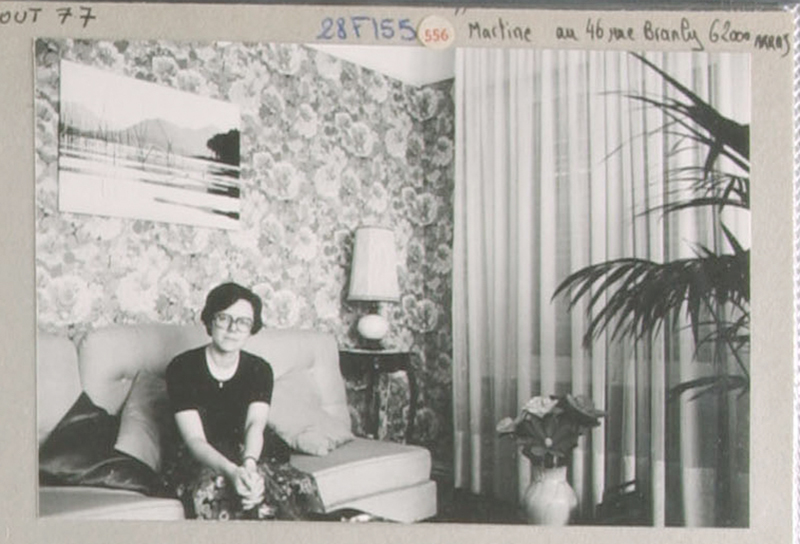
My sister Martine displayed my photo in her living room
I meet Lucien Clergue in 1999.

Lucien Clergue
|
At the same time, I was working odd jobs as a camera salesman and at hi-fi stores to keep afloat. I learned a great deal about marketing, customer service, and how to dust items on the shelves. Most important of all, I learned that only one profession interested me: freelance photographer.
|
|
In Reading, Berkshire, I was working as a salesman in a Hifi and Photography store (Herbert's HiFi, 177 Whitley Wood lane, Reading) to pay for my studies and my rent for a tiny room. Eric Curling, the best salesman I have ever met, taught me his techniques, and I learned at last to earn my living.
 |

Busy, luxury shop (not cash and carry) offering a lot of services to the customers, but with not very competitive prices. This is were the salesmanship and personality of the manager comes into account. Responsible for the turnover and welfare of the shop, selling to the customers on the premises and on home demonstrations, arranging finance facilities, deliveries, installations and service calls. Promoting sales. Trading in. Organising the stock (orders, display, control, planning). Handling cash, banking, paperwork, controlling one part-time salesman.
|
I sold Bang & Olufsen products.

BeoMaster 1900/1900-2 Tuner/Amplifier from Denmark
Manufactured: 1976 - 1982 Designer: Jacob Jensen Colours: Rosewood, Teak, White, Oak
The 1970's were exciting times for Bang & Olufsen. Another breakthrough during this decade was Beomaster 1900, a radio receiver and amplifier launched in 1976.
Once again, design and operation differed dramatically from other contemporary products. Originally designed by Jacob Jensen, Beomaster 1900, together with Beomaster 2400-2 were two advanced FM stereo receivers. They had identical technical specification and performance. Both were easy to use and easy to live with.
Beomaster 2400-2 had the additional convenience of a cordless ultrasonic remote control module by which you could operate radio, amplifier and Beogram 2400 or 4004 record deck from a distance. Both receivers had touch-sensitive controls for operating the features and functions you used every day.
All the secondary switches and adjustments were protected beneath a hinged lid, but an illuminated readout panel showed you the set's operational status at a glance. |
And the English High-End Hi-Fi : Quad

The classic QUAD 303 although very good for its vintage is now behind the times as far as sound quality and technology are concerned.
The sound quality of the 303 can now be brought up to very high performance levels with a new Power Supply circuit board (PCB) which has been specifically designed to fit inside the chassis just as the original did, but with much improved performance.
As with all audio equipment the power supply plays a crucial role in overall performance.
A weakness in the power supply will always produce deterioration in sound quality. Important aspects of the power supply are how the PSU voltages are produced and also their return path from the audio circuitry back to the power supply (the ground).
The original power supply board has been redesigned using modern components and circuit techniques. There is no longer a need for the supply voltage to be adjusted to the required value as in the previous design.
A stable voltage reference is used and then amplified using a single sided power amplifier with a set gain. This then provides a stable drift free voltage which is capable of sourcing many amps without 'sagging' more than a few mili Volts.
Close decoupling is used with low impedance components to provide an additional path to ground for any noise which may still be present on the supply rails.
This provides the best possible Power Supply for the active circuitry. As for the ground return, this is done using very low impedance ground planes which have been specifically 'split' to direct the ground currents back to the regulator ground with minimal interference of the sensitive signal grounds. |

At the same time, I also, sale
cameras at Reids Photographic in Reading, Berks, UK.

I am the bearded one on the left.

My first official business card to win customers.

I’m the one of the right, with the blue tie. |

Kate Winslet (actress in the film Titanic) was born in Reading, Berkshire, UK
 |
I met a wonderful girl, Marie-Angèle, but I was far too stupid and far from mature enough to keep her.




In Sicile, at the home of Angelo Falcone
|
 |

To : Dragon Clause Slowick, Bureau instruction, Quartier Valmy 45 160 Olivet From : Raphaël Christian Fournier Reading October 30, 1977
Dear Claudius, what is a dragon? A monster?
First, please accept my apologies for not writing earlier. Contrary to most people, just because I don’t write, it doesn’t mean I’ve forgotten. Anyway, how could I forget you? The intellectual and moral shock of your personality (a strong one, you have to admit) that has stimulated my tiny grey cells, proud of their profound independence and subtlety, is far from petering out. To the contrary, it continues to affect me in my everyday life, adding in a sunny ray of healthy optimism. It doesn’t need to be said, you live your life to the fullest. I admire that and congratulate you for it.
If I haven’t written beforehand, it’s not because I’ve got nothing to say or didn’t want to say anything, but rather because I’ve let myself get swept up in a current of incessant activity, activity which I enjoy and desire. In fact quiet moments depress me, because after a certain time of my brain running on empty, I start to overthink my actions, my words, my feelings, myself, my future self, and I become hesitant and timid, uneasy in my own skin (a little worn, now). It’s the same thing every time I transition and I am happy (and so I am successful, but the opposite is never true) hopping straight from one activity to another, without preparation, without ceremony.
Improvisation, spontaneity, afraid of nothing, not the cold, not ridicule, I become easygoing, outgoing, and cheerful. I hope you understand what I mean so that you won’t believe I’ve written to say nothing. I am a photography student. I sleep a lot and so I come home a lot. I try to emulate Boris Vian, John Lennon, Aristote, Pasteur, David Hamilton, General Custer, Lenin, Charlot and even sometimes Cleopatra. In short, underestimating myself would be a mistake, because I am RCHF himself.
I hope you’re doing well too,
Your friend, Christian
|
EExcerpt from my scrapbook at the time

Tim Horrox (bottom right), a friend from photography school who has since become the director and owner of a large audiovisual company in London
|
“Suddenly, in the space of a moment, I realized what it was that I loved about Britain - which is to say, all of it. Every last bit of it, good and bad - Marmite, village fetes, country lanes, people saying 'mustn't grumble' and 'I'm terribly sorry but', people apologizing to me when I conk them with a nameless elbow, milk in bottles, beans on toast, haymaking in June, stinging nettles, seaside piers, Ordnance Survey maps, crumpets, hot-water bottles as a necessity, drizzly Sundays - every bit of it. ― Bill Bryson, Notes from a Small Island.
|
LES POIREAUX RAVAGES
C’était une sale journée pluvieuse. Il pluviait. Il pluviait sans arrêt. Impossible de sortir sans scaphandre. Ceux qui pouvaient pas se payer de scaphandre, comme nous autres, fallait qu’ils restent dedans. C’était horrible. Il faisait un noir incroyable. Même ces grosses lampes faisaient juste un halo et y faisait toujours aussi noir.
On se sentait tout seul, très seul. Les bruits étaient étouffés. On entendait quand même régulièrement dehors le vroum des scaphandres à moteur, les fumiers. Dedans les bruits ne se faisaient plus. Les assiettes se cassaient sans fracas, la radio s’étouffait à dix mètres. On se sentait tout seul, très seul.
Au début je disais "y-a qu’a attendre". J'ai attendu. Ça a rien changé. C’était horrible. On ne pouvait rien y faire. On pouvait rien faire. Que penser. Que penser qu’on attendait. Penser à la philosophie, repenser ses souvenirs, penser de faux rêves. On a pensé beaucoup, sans ordre, sans but, longtemps. On a rien appris. On a repensé les mêmes choses, encore et encore, les plus moches, les plus banales. Et les pensées rétrécissaient. Et elles revenaient, en rond, tour à tour, à force. Et ça faisait mal, en raclant sur les bords. Et tout rétrécissait. Et ça faisait très mal. C’était horrible et on ne pouvait rien y faire.
Ha! Faut pas rester enfermé, seul, avec ses pensées, quand on n’a pas le moral.
Poème (au cas où cela ne soit pas évident) de Christian Fournier


|

I write poems
|
The Ravaged Leeks
(One felt alone, very alone. All sounds were muffled. Save for the occasional vroom of motorized diving suits, the bastards. Inside, all sounds went unheard. Plates broke without a clatter, the radio faded out at 10 metres. One felt alone, very alone.)
Au début je disais "y-a qu’a attendre". J'ai attendu. Ça a rien changé. C’était horrible. On ne pouvait rien y faire. On pouvait rien faire. Que penser. Que penser qu’on attendait. Penser à la philosophie, repenser ses souvenirs, penser de faux rêves. On a pensé beaucoup, sans ordre, sans but, longtemps. On a rien appris. On a repensé les mêmes choses, encore et encore, les plus moches, les plus banales. Et les pensées rétrécissaient. Et elles revenaient, en rond, tour à tour, à force. Et ça faisait mal, en raclant sur les bords. Et tout rétrécissait. Et ça faisait très mal. C’était horrible et on ne pouvait rien y faire.
(At first I said "The only thing to do is wait”. I waited. It changed nothing. It was horrible. There was nothing to be done. One couldn’t do anything. Apart from think. Think about waiting. Think about philosophy, think back on memories, think about false dreams. Thinking at length, without direction, without a goal, for a long time. Nothing was learned. The same thoughts, over and over, ugly thoughts, banal thoughts. The thoughts become smaller. And they returned with force, one after the other, endlessly. And it hurt, scraping the sides. And everything became small. And it hurt. It was horrible and nothing could be done about it.)
(Ha! You shouldn’t stay holed up by yourself, with your thoughts, if you’re feeling down.)
Poem (in case that wasn’t obvious) by Christian Fournier
|
Excerpt from my scrapbook at the time.

Dylan and Clapton, fabulous.
|
Le Franglish!
You Can't Read This Article Si T'es Pas Bilingue (English & Français)
Being bilingual est parmi the best pleasures dans le monde entier. Think about it pour un instant. You can utiliser deux different languages en mêne temps in a such a way that makes ton cerveau wants to exploser from the speed par la quelle it switches from one langue to l'autre but still tu peux do it and ressentir special(e) at the same time. et c'est pour ca you are unique. Le fact that tu peux lire this article without stopping to think est un talent très few people have. La majorité of people struggle to lire juste in one single language, but what you are doing maintenant est un signe of absolute genius. Reading a très complicated texte in two langues differences seamlessly makes you un(e) nerd et someone qui trouve joy in languages. Reading cet article must have given your brain a nice little workout.
That's why you should le partager avec vos amis. De rien in advance and have a très bonne journée.
|

|
 |
 |
 |
Profondeur de champ.
Pour un réglage et une utilisation donnés d'un appareil photographique, la profondeur de champ correspond à la zone de l'espace dans laquelle doit se trouver le sujet à photographier pour que l'on puisse en obtenir une image que l'œil (ou un autre système optique) acceptera comme nette. L'étendue de cette zone dépend des paramètres de la prise de vue, notamment de la distance de mise au point, de l'ouverture du diaphragme et des dimensions de la surface sensible. La connaissance de la profondeur de champ est nécessaire à la maîtrise des prises de vues, en photographie comme en cinéma et en vidéo. Dans la pratique, le contrôle de la profondeur de champ est important pour mettre en valeur un sujet dans les techniques de portrait, de paysage et de nature morte. Plus la profondeur de champ est étendue, plus elle intègre le sujet dans son environnement. A contrario, plus elle est courte, plus elle l'isole. Les plans en avant et en arrière du sujet seront alors plus ou moins flous.
Plus on ferme le diaphragme, plus la profondeur de champ est grande, mais plus la diffraction dégrade l'image. Au mieux, le pouvoir séparateur angulaire de l'œil permet de distinguer des détails de 0,33 mm à 1 m, ou de 3,3 mm à 10 m, etc., ce qui correspond à un angle d'environ 1/3000 radian.
........
|
 |
 |
As I am bilingual, people often ask me if I dream in English or in French. I dream in images. Psychologists have told me this isn’t possible. Doctors say that dreaming is obligatory. Yet the first men, before the invention of language, could not have dreamt in words, nor could a person who is deaf and mute from birth. Picasso probably considered his paintings in terms of images rather than in words.
|
1978 in 4 radio episodes:
« A device which looked rather like a largish electronic calculator. This had about a hundred tiny flat press-buttons and a screen about four inches square on which any one of a million ‘pages’ could be summoned at a moment’s notice. It looked insanely complicated, and this was one of the reasons why the snug plastic cover it fitted into had the words DON’T PANIC printed on it in large friendly letters. The other reason was that this device was in fact that most remarkable of all books ever to come out of the great publishing corporations of Ursa Minor – The Hitchhiker’s Guide to the Galaxy. The reason why it was published in the form of a micro sub-meson electronic component is that if it were printed in normal book form, an interstellar hitchhiker would require several inconveniently large buildings to carry it around in.» (de « The Hitchhiker's Guide to the Galaxy: The Complete Trilogy of Five (English Edition) » par Douglas Adams)
Tim Horrox: "Christian Fournier is Zaphod."
« Zaphod Beeblebrox, adventurer, ex-hippy, good-timer, (crook? quite possibly), manic self-publicist, terribly bad at personal relationships, often thought to be completely out to lunch. » (de « The Hitchhiker's Guide to the Galaxy: The Complete Trilogy of Five (English Edition) » par Douglas Adams) = Christian Fournier
***************************************************

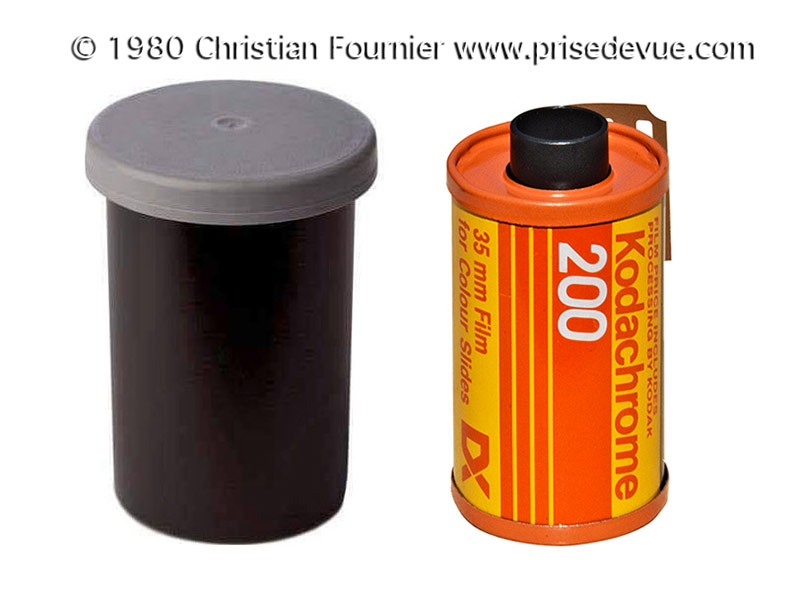 |





P = programme; S = speed vitesse; A = aperture diaphragme; M= manuel

“A photograph is a click away. A good photograph is a thousand clicks away and a better one, a million clicks away.” Kowtham Kumar K






Groupe de 300 personnes, pour Adivalor, au Stade de France.
1 - Super Assistante Camille.
2 - Eclairages Profoto D1 Air déclenchés par onde radio par le Profoto Air Remote placé sur l'appareil photo Nikon D3x de 25 millions de pixels.
3 - Mégaphone pour repositionner les gens et leur expliquer quand la photo va être faite.
4 - Nikon D600 de 25 millions de pixels comme rechange et pour le making of.
5 - Caisse Pelican à roulettes contenant tous les appareils délicats.
6 - Nikon D3x (25 millions de pixels) et objectif Nikkor 70-200mm VR2.
7 - Pied Manfrotto très grand permettant de fixer un appareil photo à 2,5 m de haut
8 - Le gardien du Stade de France qui veille à ce que personne ne marche sur la pelouse, selon les clauses mises sur le contrat de location
9 - Les côtés du Stade de France très bien éclairés. Malheureusement, le centre et le groupe n'ont pas pu être éclairés, contrairement au contrat de location
Non visible sur la photo, l'assistant Laurent qui prend cette photo et les mètres de câbles qui amènent le 220 Volts aux 6 flashs Profoto D1 Air. Evidemment, de nos jours, en 2017, Profoto a créé des flashs qui fonctionnent très bien sur accus autonomes.





Nous voyons des photos spectaculaires, mais nous oublions souvent les photographes qui les ont prises.



Hire a photographer ?
What you think you're paying for:
Someone who can take photos.
What you're actually paying for:
Someone who can create images
that will meet your requirements,
�
PLUS
- Camera equipment
- Lighting equipment
- Computer equipment
- Image editing software
- Hundreds of hours of training
to operate all above effectively
- Data storage and back-ups
- Studio space or location fees
- Office rent and expenses
- Promotion and web site costs
- Telephone costs, mobile and home
- Income and sales taxes
- Business insurance
- Assistant
- Food, housing, etc ...
2019 : Over the years, I have photographed great photographers

1 Sebastiao Salgado
2 Paolo Roversi et Christian Fournier
3 Yann Arthus Bertrand et Christian Fournier
4 Jean-Baptiste Mondino et Christian Fournier
5 Peter Lindbergh et Christian Fournier
6 Peter Beard et Christian Fournier
7 Louis Stettner
8 Antoine Schneck et Christian Fournier
9 Bettina Rheims
10 Remy Poinot
11 Jean-Jacques Annaud (metteur en scène et aussi grand photographe) et Christian Fournier
12 Karl Lagerfeld
13 Lucien Clergue
14 Arthur Edwards
15 Reza Deghati
16 Raymond Depardon et Christian Fournier
17 Robert Clark from National Geographic
18 Roger Ballen
19 Uwe Ommer et Christian Fournier
20 Dean Collins et Christian Fournier
21 Rony Willis


J'apprends beaucoup sur comment poser les gens






Music imprints itself in the brain deeper than any other human experience
Some LPs of my youth.
 
 |






























































































